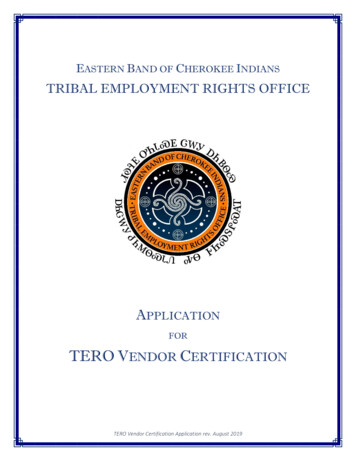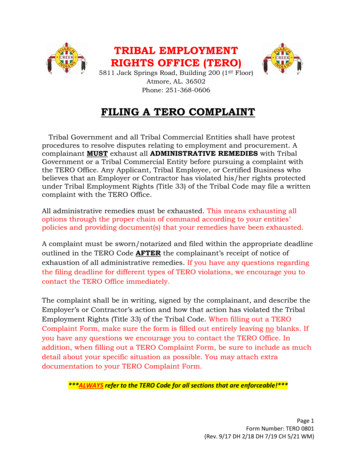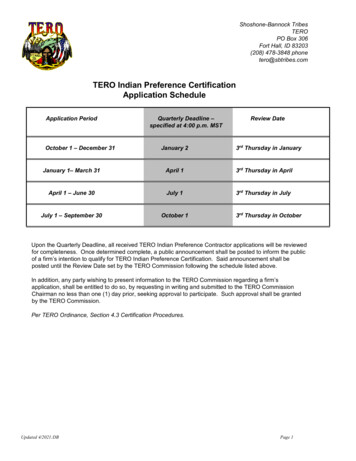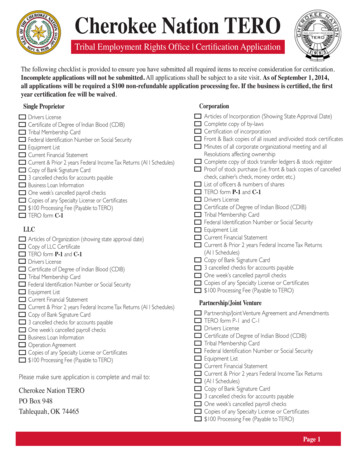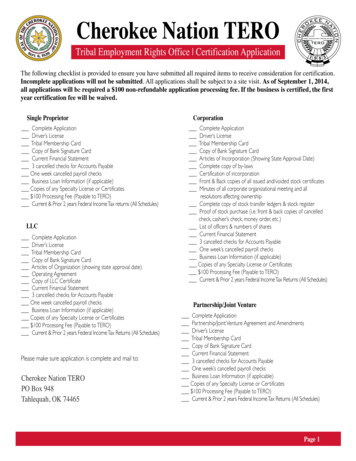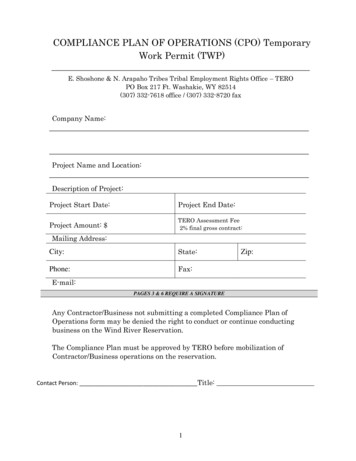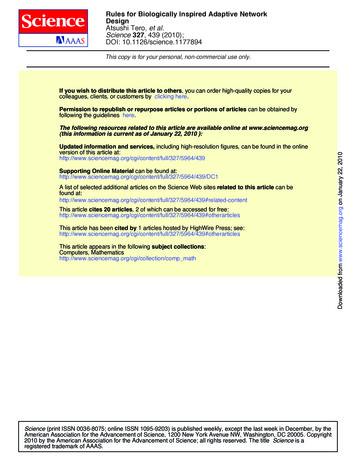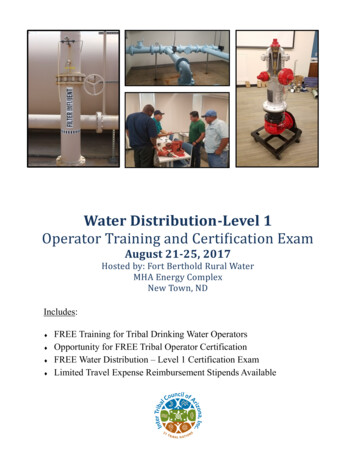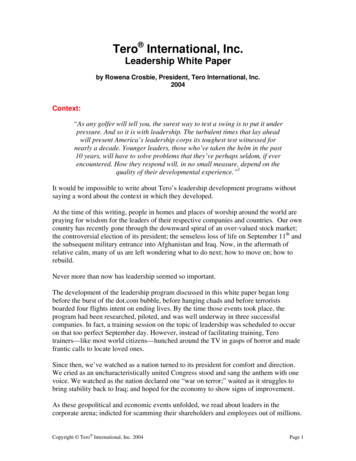
Transcription
Tero International, Inc.Leadership White Paperby Rowena Crosbie, President, Tero International, Inc.2004Context:“As any golfer will tell you, the surest way to test a swing is to put it underpressure. And so it is with leadership. The turbulent times that lay aheadwill present America’s leadership corps its toughest test witnessed fornearly a decade. Younger leaders, those who’ve taken the helm in the past10 years, will have to solve problems that they’ve perhaps seldom, if everencountered. How they respond will, in no small measure, depend on thequality of their developmental experience.”1It would be impossible to write about Tero’s leadership development programs withoutsaying a word about the context in which they developed.At the time of this writing, people in homes and places of worship around the world arepraying for wisdom for the leaders of their respective companies and countries. Our owncountry has recently gone through the downward spiral of an over-valued stock market;the controversial election of its president; the senseless loss of life on September 11th andthe subsequent military entrance into Afghanistan and Iraq. Now, in the aftermath ofrelative calm, many of us are left wondering what to do next; how to move on; how torebuild.Never more than now has leadership seemed so important.The development of the leadership program discussed in this white paper began longbefore the burst of the dot.com bubble, before hanging chads and before terroristsboarded four flights intent on ending lives. By the time those events took place, theprogram had been researched, piloted, and was well underway in three successfulcompanies. In fact, a training session on the topic of leadership was scheduled to occuron that too perfect September day. However, instead of facilitating training, Terotrainers—like most world citizens—hunched around the TV in gasps of horror and madefrantic calls to locate loved ones.Since then, we’ve watched as a nation turned to its president for comfort and direction.We cried as an uncharacteristically united Congress stood and sang the anthem with onevoice. We watched as the nation declared one “war on terror;” waited as it struggles tobring stability back to Iraq; and hoped for the economy to show signs of improvement.As these geopolitical and economic events unfolded, we read about leaders in thecorporate arena; indicted for scamming their shareholders and employees out of millions.Copyright Tero International, Inc. 2004Page 1
We listened as these same leaders insisted that they get the performance bonuses they hadcoming to them. We’ve also watched as leaders were the first to take pay cuts when theircompanies struggled in a struggling economy. And we felt proud when an Iowa seedcompany made the national news for awarding its employees a one-time Christmas bonusof 1,000 for each year of employment.It might seem that against this backdrop of leadership gone awry and leadership donewell, Tero would have plenty of fodder for research on the great new leaders of the early21st century.But leadership isn’t really about all that—or at least not to Tero. Even before the eventsof September the 11th, Enron, or WorldCom, Tero held loosely to the notion of the largerthan life Leader with a capital “L.” The age of unmitigated belief in the charismaticfigure who would fix the world seemed to have come and gone as too many of us realizedthat they were just too human. Tero was and continues to be inspired by the notion ofdeveloping leaders because Tero believes in the leaders with a lower-case “l.” These arethe people who practice leadership wherever they are. They may not be in positions ofgreat authority or prestige, but they challenge the status quo, motivate and empowerothers and make the world around them a better place by courageously communicating aclear vision for productive change in whichever situation they find themselves. BeforeSeptember 11th, Tero was calling these kinds of people “everyday leaders.” Now weknow them by names like the NYFD, and the crew and passengers of United flight 93. Itis in these kinds of leaders that Tero believes and trains—with all its heart.But it wasn’t always like that; in the beginning, the research behind Tero’s programbegan—as most good research begins—with questions.Copyright Tero International, Inc. 2004Page 2
1. IntroductionWhy leadership development?Tero is in the business of training professionals to understand and use skills that willenhance their personal and professional lives. There are technical skills (writing, typing,accounting, etc.) that can enhance one’s personal and professional life, but Tero hasalways focused on the “soft” skills.Since 1993, Tero has dedicated itself to understanding the abstract personal andinterpersonal skills necessary for success in the workplace. Tero invests hundreds ofhours in research, program design and curriculum development to translate the abundantand complex findings of research scientists into relevant, practical and fun trainingprograms that make a real difference to the bottom line for it’s clients.Are the soft skills important? Norman Cousins, former Saturday Review of Literatureeditor and UCLA Professor said it this way:The words “hard” and “soft” are generally used by medical students todescribe the contrasting nature of courses. Courses like biochemistry,physics, pharmacology, anatomy, and pathology are anointed with thebenediction of “hard,” whereas subjects like medical ethics, philosophy,history, and patient-physician relationships tend to labor under the farless auspicious label “soft” . . . [But] a decade or two after graduationthere tends to be an inversion. That which was supposed to be hard turnsout to be soft, and vice versa. The knowledge base of medicine isconstantly changing . . . . But the soft subjects – especially those that haveto do with intangibles – turn out to be of enduring value.2These observations from the medical world offer great insight for professionals ingovernment and industry everywhere – and perhaps for none more than those who lead.Where new discoveries and changes in nearly every profession necessitate the constantlearning and re-learning of technical knowledge, most people would agree with Cousinsabout the enduring value of the intangible soft skills. Interestingly, it is often those samepeople who struggle to define these skills, precisely because they seem intangible.Because of their complex and intangible nature, the training and development of personaland interpersonal skills is largely overlooked in traditional education leaving leaders (infact, most people) to pick them up on an ad hoc basis. For many, their training in the softskills is less than effective because it is received from parents, teachers, coaches, peersand managers who themselves, albeit well-intentioned, have been taught ineffectivemethods of relating. For everyone who has wrestled with how to deliver bad news to anemployee, handle an emotional conflict, motivate a team, calm their own anger, inspireothers toward a vision or persuade an audience to a course of action, it is vividly clear ona deep personal level how hard the soft interpersonal skills can be to master. Helpingpeople make tangible, define, develop and effectively use the soft skills that provideenduring value is Tero’s mission.Copyright Tero International, Inc. 2004Page 3
Psychologist and researcher Daniel Goleman coined the phrase “emotional intelligence”to refer to the possession and use of soft skills. His research revealed that although softskills are harder to teach and harder to learn than technical skills, they contribute more toan employee’s ultimate success or failure than do technical skills or raw brainpower.3Goleman’s research is supported by research conducted by Harvard University, theCarnegie Foundation and the Stanford Research Institute which has shown that technicalskills and knowledge account for about 15 percent of the reason an individual gets a job,keeps the job and advances in that job. The remaining 85 percent of job success is basedon the individual’s “people skills.” 4 Similarly, in his book entitled People Skills, authorRobert Bolton reports that 80 percent of the people who fail at work, do not fail due totheir lack of technical skills but rather because of their inability to relate well withothers.5 Breakthrough research like this led Tero to question: Is having a group of peoplefully versed in the finer points of soft skills enough to guarantee success in business?Which combination of soft skills will carry individuals and the companies for which theywork into future success?At the time when Tero began asking itself these questions, the shelves of bookstores hadalready begun to sag under the weight of books on leadership. The business environmenthad continued to orient itself toward intangibles (like service and intellectual capital) andthe age of the personal computer and internet had begun to dawn for the masses. Itseemed that change itself was changing at a faster and faster rate. Businesses began tolook for leaders to comfort and guide them through change. “Management” as a functionbecame vilified as pertaining only to those small-minded, number crunching controlfreaks who weren’t hip to the changing times. Even leadership mavens like WarrenBennis and Harvard’s Abraham Zaleznick described managers as people who “do thingsright” compared to leaders who “do the right things.”6 & 7The extreme swing away from management and toward leadership was unfortunatebecause it denigrated the valuable role a manager can and must play within anorganization. However, it was a timely shift because while good management is vital forthe maintenance of an established system, leadership is required in the face of change. Infact, when leadership researchers James Kouzes and Barry Posner asked recognizedleaders to describe their personal best leadership experiences, almost everyone spoke of achange of some kind.8 Or, as Harvard’s John Kotter described it; “leadership is theprocess that produces movement in the long-term best interest of the group.”9The world has continued to change and businesses will move with it or die. For Tero, thedirection was clear: we had to create a program that would develop within people the softskills necessary for the process of inspiring others to commit to movement towardchange.What is the Best Way to Develop Leaders?Given the need for leadership, it’s only logical to question how best to develop leaders.This is not a new question. Nor is it a question that has been answered or implementedCopyright Tero International, Inc. 2004Page 4
satisfactorily by many organizations. In 1977, in his article Managers and Leaders: AreThey Different? Abraham Zaleznik explains one of the challenges of leadershipdevelopment. He argues that, while businesses must find a way to develop leaders,corporate culture, because of its conservatism and risk-adverse nature (particularly inlarge organizations), actually stifles leadership development. He goes on further to say“There are no known ways to train great leaders.”10 More than two and a half decadeslater, the question about the best way to develop leaders remains. In his book, TheLeadership Factor, John Kotter reported that the Opinion Research Corporationconducted a study which revealed the severity of the leadership deficit. In the 1970s, 69%of executives surveyed rated their organizations as “good” or “very good” at attracting,developing and maintaining potential leaders. By the early 1980s, that percentage hadfallen to 47%. In 1984, not one of the 250 firms surveyed received “excellent” ratings.Less than 7% were rated “very good” and 93% received a lower rating.11Recent studies on perceptions of the efficacy of leadership development seem to indicatethat development efforts have improved slightly, but are still not where they should be. InSeptember 2002, Training Magazine and the Center for Creative Leadership publishedthe results of a joint survey of 225 respondents. When asked to rank their company’s useof “ many different development activities (e.g. job assignments, coaches and mentors,training programs, experiences outside of work) utilized to help people develop theirleadership competencies,” the average score was 2.89 on a 5-point scale (in which “5” is“strongly agree.”)11It would seem that the passage of time has only added to the ardor and confusion overquality leadership development. In the fall of 2002, a casual Google query for“Leadership Training” yielded 245,000 web sites. Among the top ten were the followinghelpful and hopeful possibilities:yyyyyBuford P. Fuddwhacker’s ConsultingOutdoor Leadership AdventuresSmall Business Development in NamibiaSALT: “Claiming the North, Preaching the Word, Reaching the Lost”Seminars in Leadership, Teamwork and Problem-solving with Foam SwordsThe number of books on the subject of leadership has continued to proliferate as well. Onthe one-year anniversary of September 11th 2001—a day when people continued to seekleadership to guide them through the ongoing confusion—there were 683 books onleadership listed on Amazon.com. Now you can learn lessons of leadership from almostany CEO of a big company, Jesus Christ, Queen Elizabeth I, Abraham Lincoln, UlyssesS. Grant, and the Wizard of Oz. Or, you can attempt to overcome The 5 Temptations of aCEO, and master The 12 Qualities that Make You a Leader, as well as The 108 Skills ofNatural Born Leaders. While you’re doing that, you really should learn The 15 Secrets ofLeadership Effectiveness Based on John Wooden’s Pyramid of Success and take care notto break The 21 Irrefutable Laws of Leadership or The 17 Indispensible Laws ofTeamwork. If all else fails, you can glean The Leadership Secrets of Atila the Hun ordiscover how things turn out when The One Minute Manager Meets the Monkey.Copyright Tero International, Inc. 2004Page 5
Is it any wonder there is such confusion over the subject of the best way to developleadership? The pursuit of the answer to the question “What is the best way to developleaders?” is what drove the creation Tero’s Leadership Development Program—or “BootCamp,” as the Tero staff refers to it due to its intensive nature. It is that question whichwill set the stage for this white paper.The rest of this paper will describe the following:2. Tero’s Training Philosophy3. The Path of the Leadership Development Program4. Overview of Course Content and Examples of Learning5. How Clients Used the Program6. Research from First Generation Boot Camps (2001-2002)7. Research from Second Generation Boot Camps (2002/2003)8. Comparison of Tero Leadership Program Delivery to that of Other ProgramDelivery Methods9. Lessons Learned and Potential Areas for Growth10. ConclusionsCopyright Tero International, Inc. 2004Page 6
2. Tero’s Training PhilosophyPrinciples Underlying All Tero WorkshopsThe best way to understand Tero’s leadership program is to gain an understanding of howTero approaches all training challenges.Almost always, the approach is heavily influenced by Tero’s flagship program—a twoday presentation skills program called IMPACT - How to Speak Your Way to Success.This program was designed and launched after hundreds of hours of research and hasbecome Tero’s most popular program numbering thousands of graduates from countriesacross the globe.Two of the basic tenets of the IMPACT workshop form the basis of all of Tero’sprograms: delivery is everything and learning is only half the battle.First: Delivery is everything.There are a lot of wrong ways to do training. To reach people, the trainer must take intoaccount and overcome things like yyyyyyyyyyThe different learning styles represented by any given group of people,Their different personality preferences,Learner readiness (were they forced to come to training?),Varying levels of experience with the company,Corporate politics,Diversity of life experience,Possible learning disorders,The time of day,Room set-up and lighting,The season of the year, etc.With all of the above things to consider, it is very difficult to say anything conclusiveabout the one right way to train people every time. However, at Tero, there are somebasic guidelines that under-gird every proprietary program. Most of the guidelines arebased on cutting edge research about how the brain receives and processes information.And, most of the guidelines are flexible enough to accommodate differences among theparticipants.Brain-based learning expert Eric Jensen explains that the brain is always paying attention.The question is: To what is it paying attention during training sessions? The goal ofTero’s training programs is to harness that attention and focus it on the learning objectiveat hand. Tero trainers accomplish this by providing a lot of variety in format, activitiesand topics. As Jensen suggests, “If you want attention, provide a strong contrast fromwhat you were just doing.”12 Strong contrasts can come in the form of differences inCopyright Tero International, Inc. 2004Page 7
volume, cadence, movement, color or location. Simply doing something adults didn’texpect you to do is often enough to gain their full attention.Perhaps the best way to gain a participant’s attention, however, is to make them getinvolved—kinesthetic learning. Whether it’s getting up and moving around, taking theirown notes, working together in groups, or actually physically practicing the skills beingtaught, all Tero programs depend heavily on learner involvement. Getting peopleinvolved in the learning not only ensures that it is their brain that is doing the work oflearning (and not just the facilitators’), it provides enough variety to appeal to thediversity of learning and personality styles in any given room.Another good reason for depending heavily on kinesthetic learning is that brainresearchers have found that learning is not a merely cerebral activity. In fact, the bestlearning occurs when the brain is able to build an entire network of connecting neurons tothe new knowledge or skill. To do this, the material must be presented in a variety offormats and accessible with a variety of cues practiced with meaningful repetition.13 Thishelps the brain build many different associations to the same piece of information. Just asknowing several routes to work will allow you to most effectively reach your job; aparticipant learns something best, when he/she has practiced several different ways ofaccessing that piece of knowledge or habit of mind. For this reason, Tero workshopsalways utilize different forms of actively practicing the subject matter.Another standard Tero practice is frequent breaks. Brain researchers have found that thebrain operates on 90-110 minute cycles of attention. Trying to gain someone’s attentionat the bottom of that cycle is not only difficult, it may be counterproductive. ResearchersRossi and Nimmons found that taking breaks several times a day actually increasesproductivity.14 Moreover, breaks allow time for assimilation and processing .12Tero believes that effective training design is only part of the solution. Great content anddesign in the hands of a poor trainer does not produce desired results. Certified Terofacilitators lead Tero’s state-of-the-art training programs. In order to be eligible forcertification, Tero facilitators must themselves undergo hundreds of hours of training anddevelopment to become experts in learning and skilled in the nuances of effectivepresentation and facilitation skills.Individuals who have been invited to participate in Tero’s facilitator certificationprograms already poses a number of unique skills and talents that Tero believes willcontribute to success in working with individuals who are building important personaland interpersonal skills. However, potential Tero trainers are told that certification is notautomatic nor guaranteed. Fewer than 20 percent of the individuals who are invited tobegin Tero’s facilitator certification program are awarded certification. Among otherthings certified Tero trainers must adopt the Tero mission and values as their own.Tero International Inc.’s MissionCopyright Tero International, Inc. 2004Page 8
yTo show people how to successfully unleash their potential by learning and applyingcomplex personal and interpersonal skills concepts into their everyday lives. We dothis by offering the very best skill development programs available.yTo provide members of the Tero team with unparalleled opportunities for careerachievement and personal growth.yTo achieve total client satisfaction by focusing on innovation, quality, and customizedone-to-one individual service.Tero International Inc.’s ValuesyIntegrity, fairness and the Golden Rule guide every business decision.yThe highest professional standards of honesty, ethical standards and responsibility arepromoted in all aspects of the business.yAll people are valued and respected for their diversity, their individual learning stylesand their preferred approaches to work.yQuality and innovation in our products and services is of critical importance.yA positive attitude provides the necessary inspiration to achieve our ambitious goals.In addition to the adherence to and practice of the above mission and values, certifiedTero facilitators must demonstrate proficiency in the following competency areas andcertification must be renewed annually at a mandatory Tero facilitator retreat.yProgram Content/Knowledge: Facilitators must obviously have completefamiliarity with the concepts explored during the program as well as the research onwhich the concepts are based. Additionally, Tero facilitators must be able tocompetently model the skills explored during the workshop. This competency isprogram-specific to each workshop.yPresentation Skills: In all classes facilitators must competently model the TeroIMPACT presentation skills.yCreating A Safe Environment: Tero trainers learn how to create an open,comfortable, safe, non-threatening environment for learning and use a variety offacilitation methods to meet learning objectives.yQuestioning Techniques: Tero facilitators are taught to use questioning techniquesto get information, check for understanding and involve participants.yManaging Group Dynamics: Tero trainers must also be skilled at the art of gettinggroup involvement, identifying and managing concern or confusion, bringing issuesCopyright Tero International, Inc. 2004Page 9
to closure, respecting everyone’s feelings and ideas, and being flexible andresponsive.yFeedback Skills: As part of group dynamics management, Tero facilitators shoulddemonstrate effective feedback skills by describing specific behavior (both positiveand negative) and suggesting alternative positive behavior.yPlanning and Organizing: All Tero classes are choreographed to feel flexible andfluid to participants while at the same time being very structured. This means Terofacilitators must plan ahead, finish early, coordinate materials, visuals and equipmentand manage workshop logistics.yCreativity in Meeting Learning Objectives: As part of the art of managing groupdynamics, Tero facilitators are encouraged to look for and seize upon unexpectedlearning opportunities when they present themselves. This often requires that thefacilitator show initiative and use innovative and creative approaches to learningwhile meeting the learning objectives. Sometimes it even means doing real-timeprogram customization to meet the specific needs of the group.yInterpersonal Skills: Certified Tero trainers must also demonstrate effectiveinterpersonal skills by looking for opportunities to enhance the self-esteem ofparticipants, using effective listening skills, negotiating win-win solutions to conflict,seeking to understand the unique needs of individuals and encouraging participantinvolvement.Second: Learning is only half the battle.Good delivery is vital, but not enough. Many trainers are delighted if their audiencewalks away “having learned one good idea.” As participants of Tero’s IMPACT workshop come to understand about their own presentations; learning cannot be the finalgoal. Simply knowing the information is not enough to compel someone to act on theinformation. If it were, the world would be a vastly different place. How many of us havelearned something about the importance of exercise, a proper diet, and sufficient sleep,yet fail to implement what we know? Learning is important, but must be followed by apersuasive and compelling call to action. This is especially true in a training context. Sohow do you persuade someone to act?In his book Rhetoric, Aristotle described the three things required to persuade anotherperson to act. One must appeal to logos (Greek word meaning “logic”), appeal to pathos(Greek word meaning “emotions”), and appeal to ethos (Greek word meaning“disposition” or “character”). In other words, if I’m trying to persuade you to act, it has tomake sense to you; you have to feel good about it; and you have to trust the person withwhom you’re interacting. The leadership program has three built-in mechanisms thataccess all three of Aristotle’s points of persuasion.1. Participants develop a strong support system within the organization.Copyright Tero International, Inc. 2004Page 10
2. They are given and choose responsibilities so they feel accountable for their ownresults.3. Class sizes are kept small so that participants can develop relationships with oneanother and the Tero trainers.Over time and with practice, Tero has learned that of all the persuasive forces in place,the relationships are the most compelling.Tero’s Assumptions and Beliefs about TrainingTero programs are all designed with an eye for the delivery and persuasion elementsdescribed above. Delivery and persuasion are only appropriate, however, if training isbeing done for the right reasons and integrated into the client company culture. Eventhough most people claim to know the word “training” and use it in everyday contexts,Tero trainers know that it means vastly different things to different people.Therefore with the goal of establishing clear understanding of what Tero means when ituses the word, Tero trainers begin every leadership program sales call with anexplanation of its assumptions and beliefs about training. Wrapped up together, theseassumptions and beliefs form the basis of Tero’s training philosophy. The intent is to laythe foundation of expectation for the potential client with regard to what Tero believesabout training.Tero’s assumptions and beliefs about corporate training are the following:yTraining must be engaging, transferable and aligned with the company’s strategicgoals.yTraining is not always the solution.yTrainers go home.yLearning takes time.ySkill-building requires support and reinforcement.ySkill-building requires dedicated attention.Training Must Be Engaging, TransferableAND Aligned with the Company’s Strategic GoalsTraining should be engaging. Fortunately, there is a veritable multitude of engagingleadership development options. In order to learn leadership you can choose amongoptions like camping in the wilderness, engaging in desert or Native American retreats, orCopyright Tero International, Inc. 2004Page 11
white water rafting. Or, you can get your entire team stuck on a giant log with animpossible task while certified safety instructors stand by to make sure your harnessesdon’t come unfastened.There is no question that exercises like this are engaging. Participants also often reportthat they had fun and that social boundaries were broken down in the process. However,the real question is whether the exercises are also transferable to the real world in generaland to the company’s strategic plan in specific. Or, if they are just as Tero team membersoften say, best at showing the team “to whom to turn for help next time you are stuck ona giant log together.”As previously discussed, Tero workshops are highly kinesthetic. However, the differencebetween mere activity and a good training exercise is the extent to which it reinforces orteaches the intended concept or skill. There’s no question that it is difficult to design alearning activity that is engaging and relevant. However, if it is just engaging, it’s nomore than entertainment—which is fine—but it isn’t training. The sign of a bad trainingactivity according to Tero trainers is having to say: “The point of this exercisewas .”The Tero philosophy is that the point of the exercise should be obvious and enlighteningor it’s not worth the time.Another critically important aspect of designing engaging and transferable training is thelearning environment. This isn’t easy. In the late 1980s, researchers Timothy Baldwinand J. Kevin Ford found that only 10% of the skills taught in company training programstransferred to day-to-day practice on the job.15 Sadly, no one really knows if this low rateof return has improved or worsened because research on training transferability is seldommeasured. An American Society for Training and Development (ASTD) survey in 1996found that only 13% of companies surveyed evaluated training in terms of on-the-jobperformance.16 The 2002 ASTD State of the Industry Review indicated that the numberof companies evaluating on-the-job impact of training had gone up to 21%.17Tero tries to overcome those odds by creating a training environment that mimics theenvironment of the real world while still providing a safe learning environment. It’s adelicate balance. Brain based experts call this “matching states.” Eric Jensen defines“state” as the “snapshot of the mind-body in one moment: your brain’s chemical balance,body temperature, posture, eye pattern, heartbeat, EEG, etc.”12 Matching states requirescreating a learning environment that is as close as possible to the environment in whichthe skills will be used.The U.S. military learn
well, Tero would have plenty of fodder for research on the great new leaders of the early 21st century. But leadership isn't really about all that—or at least not to Tero. Even before the events of September the 11th, Enron, or WorldCom, Tero held loosely to the notion of the larger than life Leader with a capital "L."

